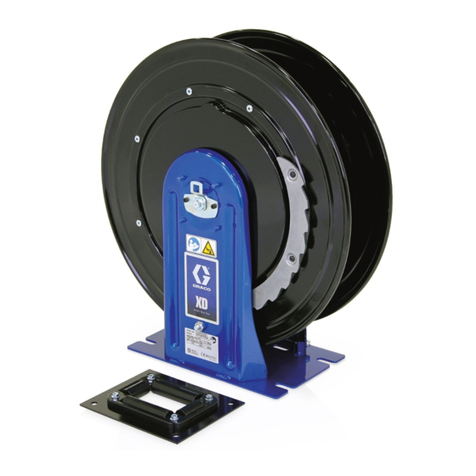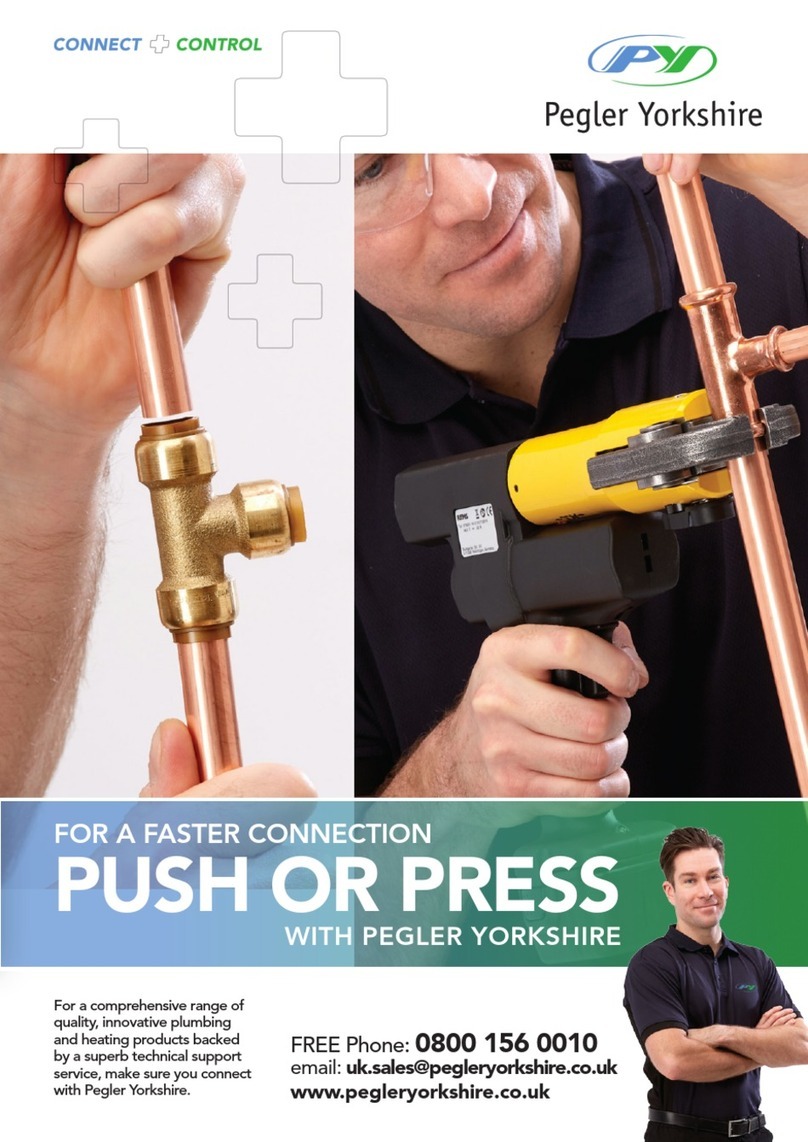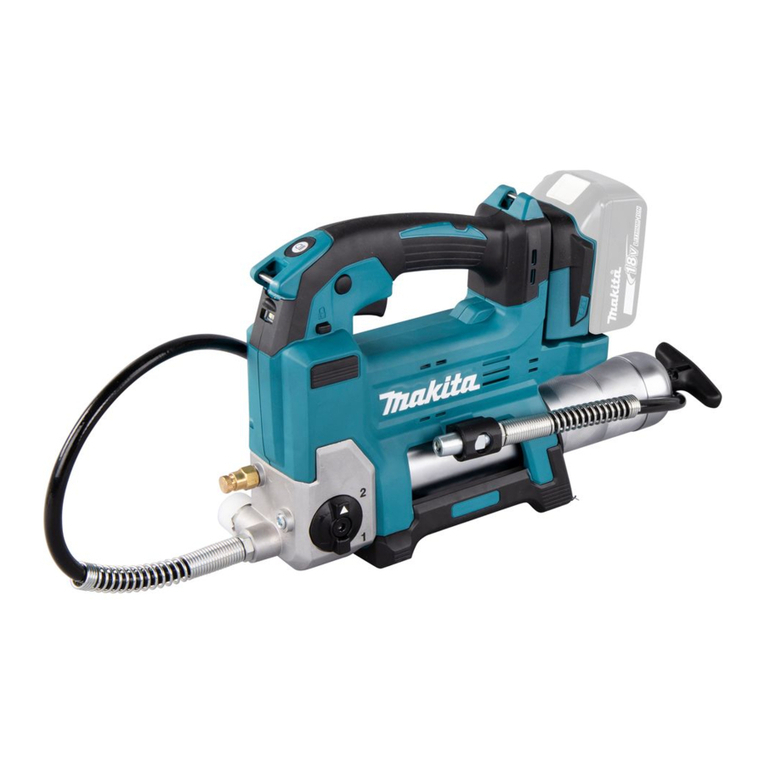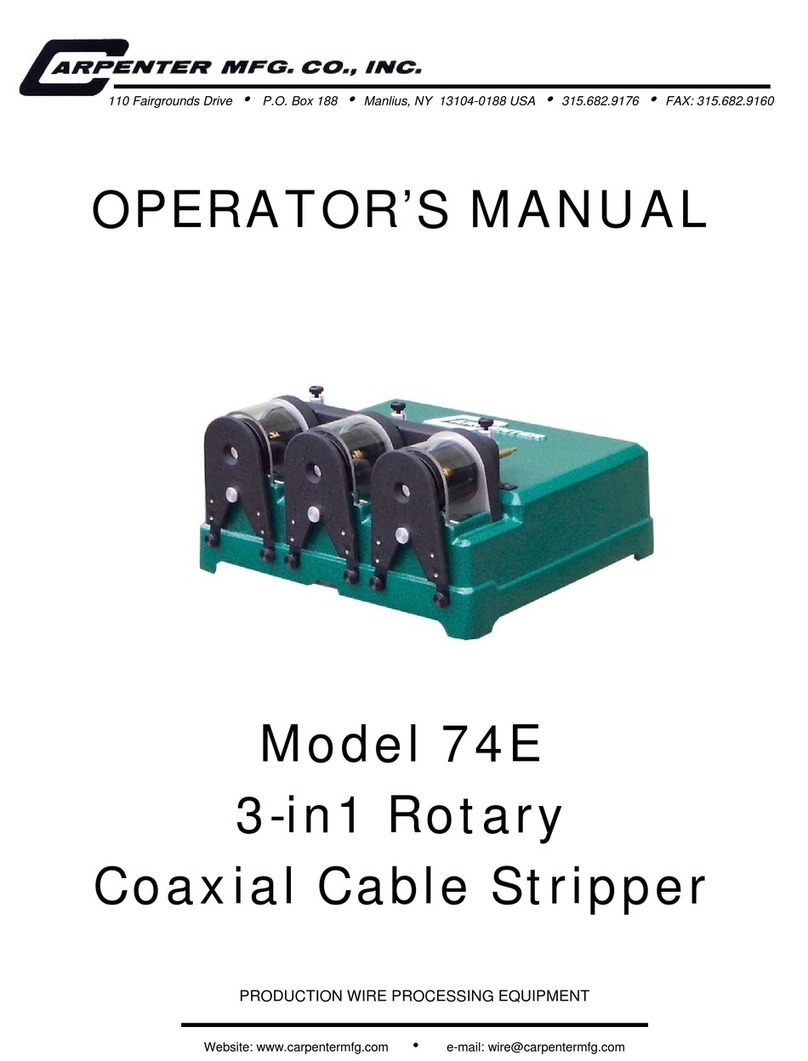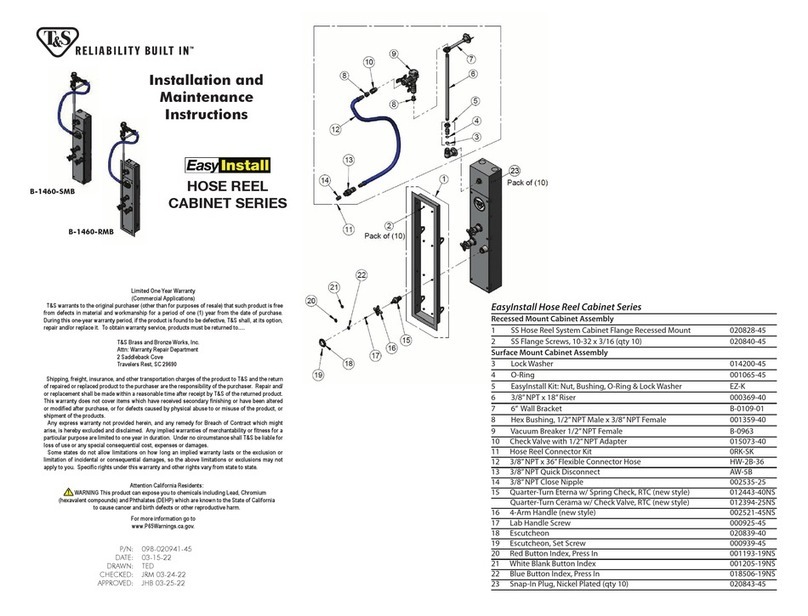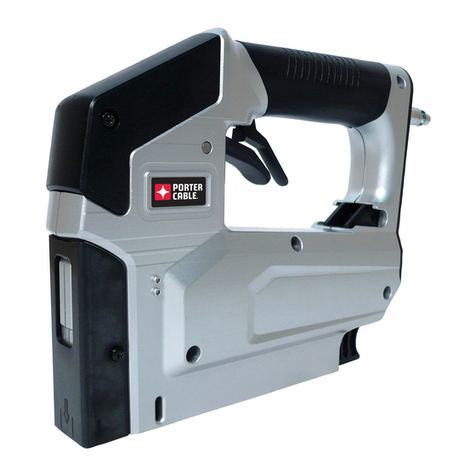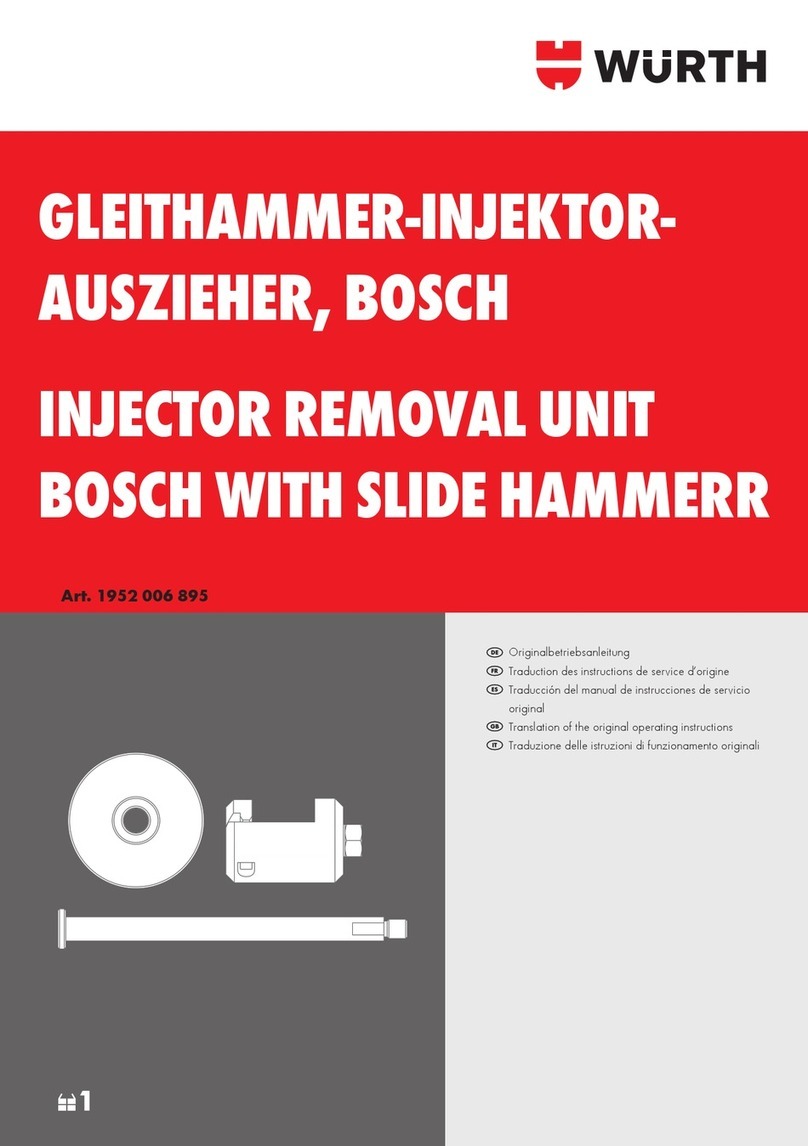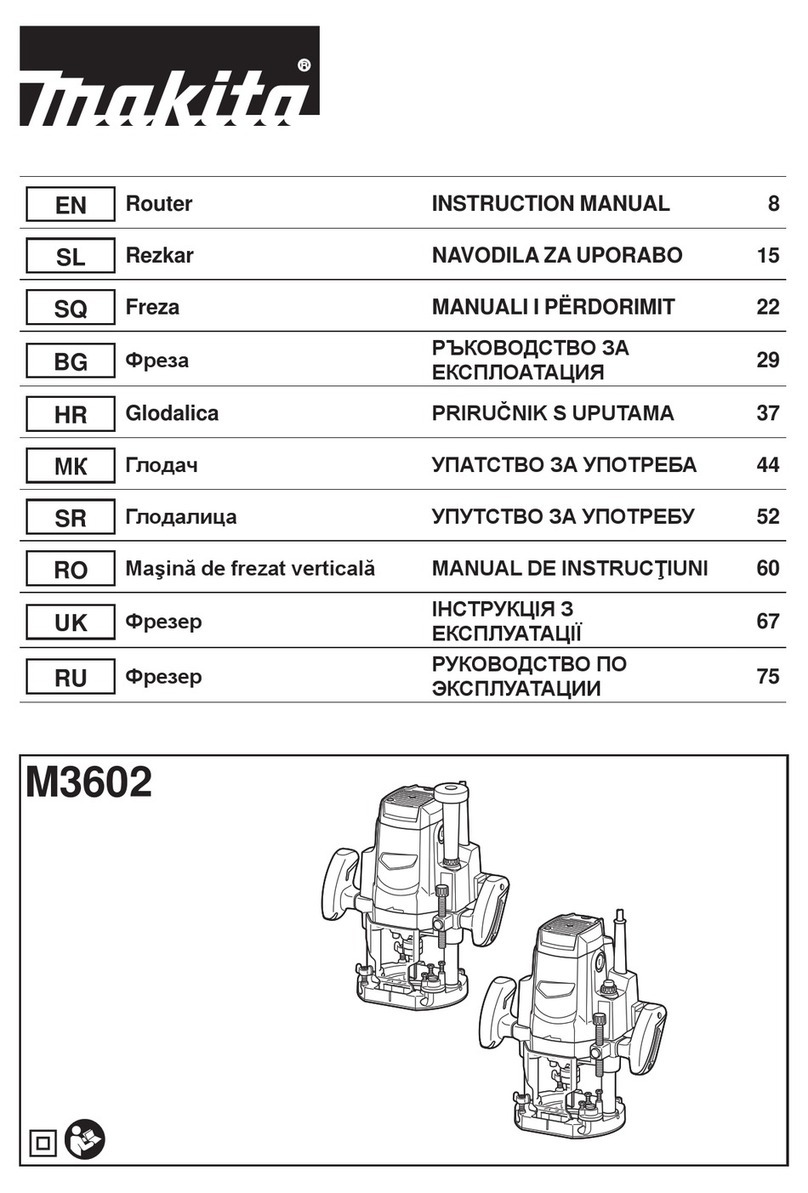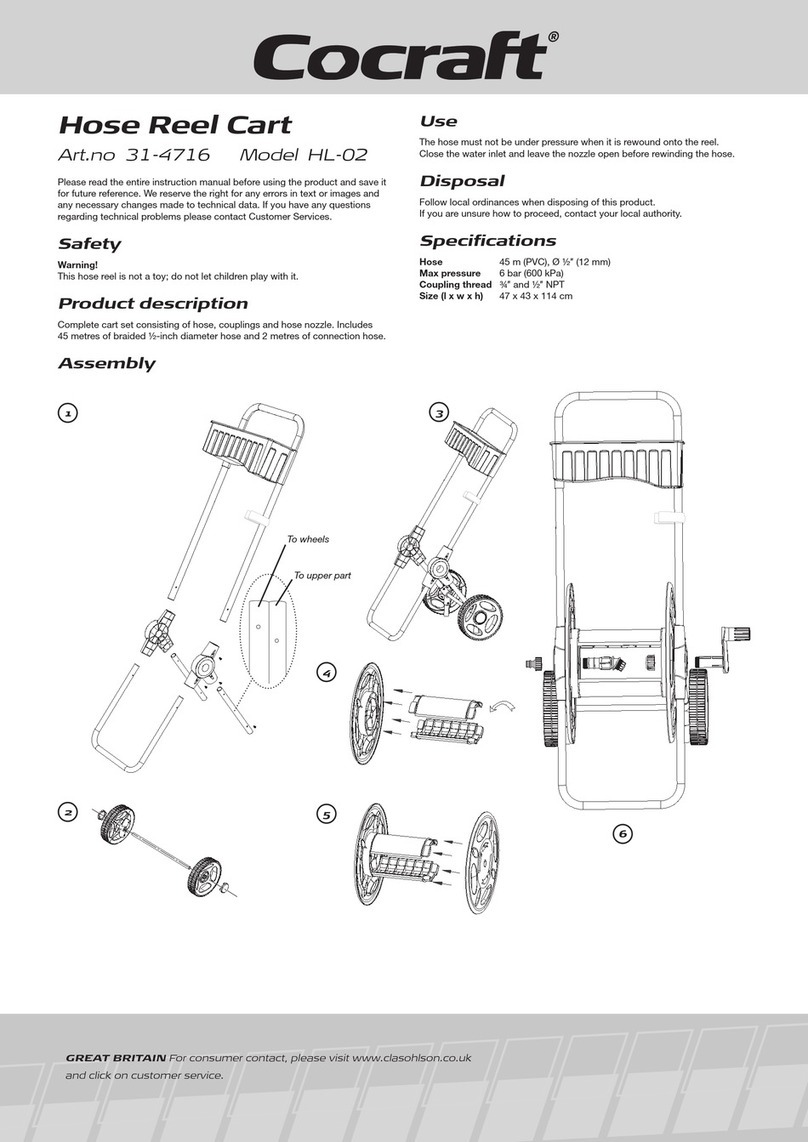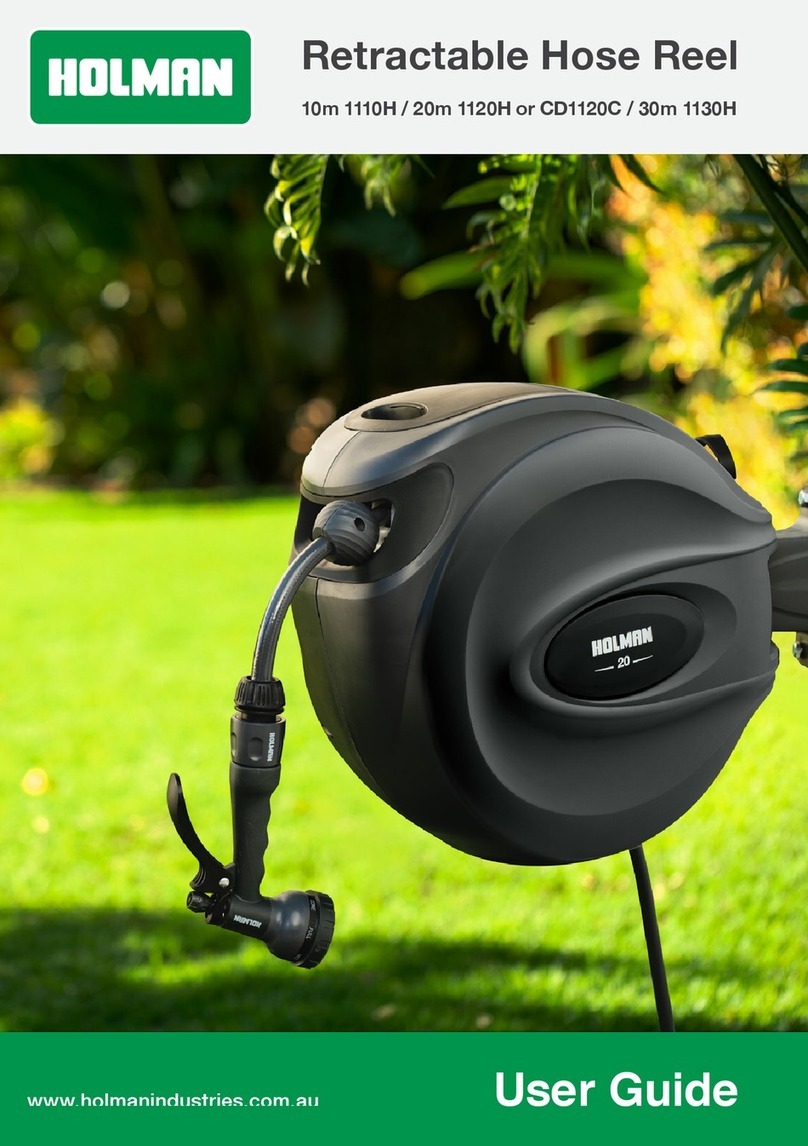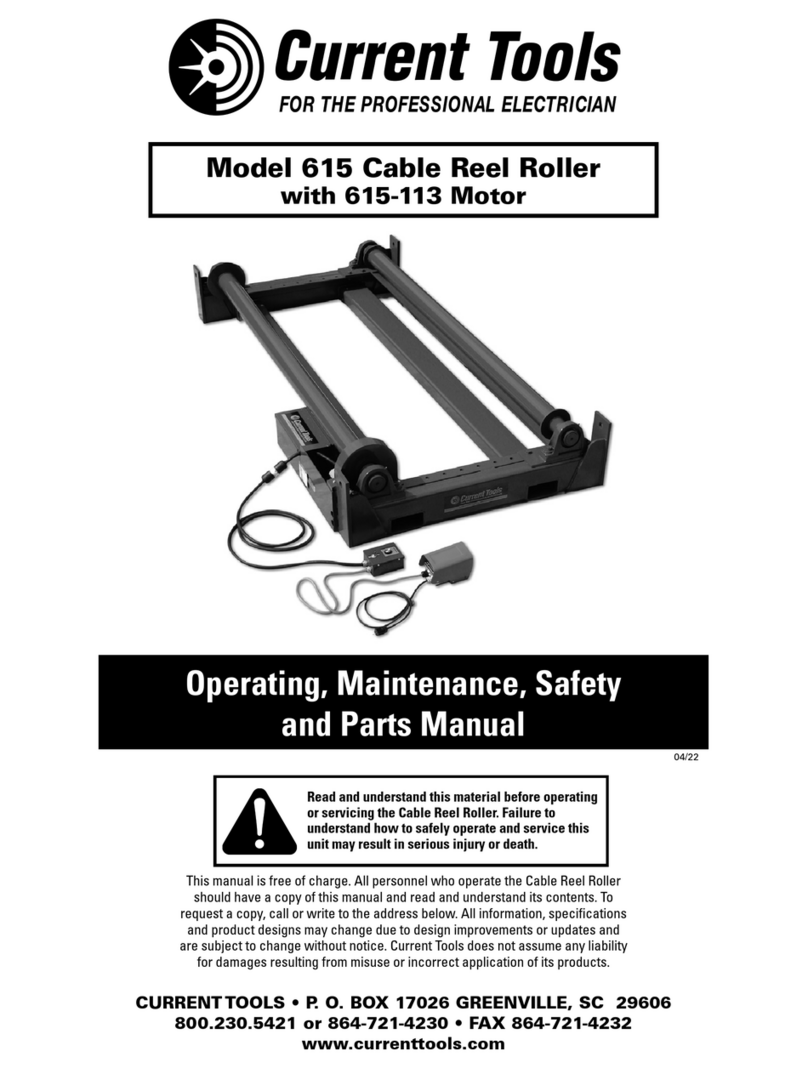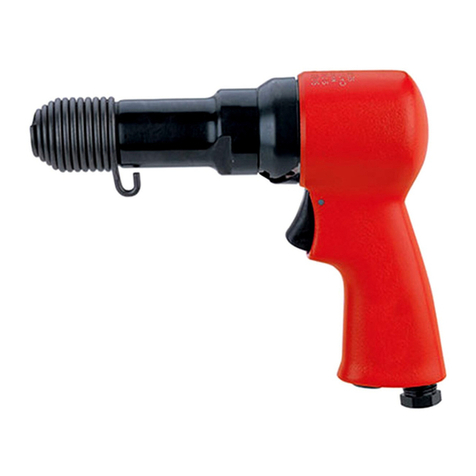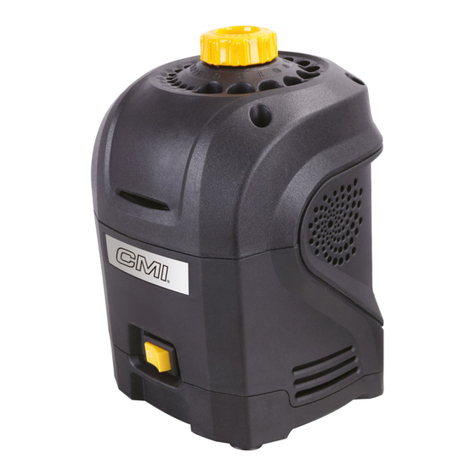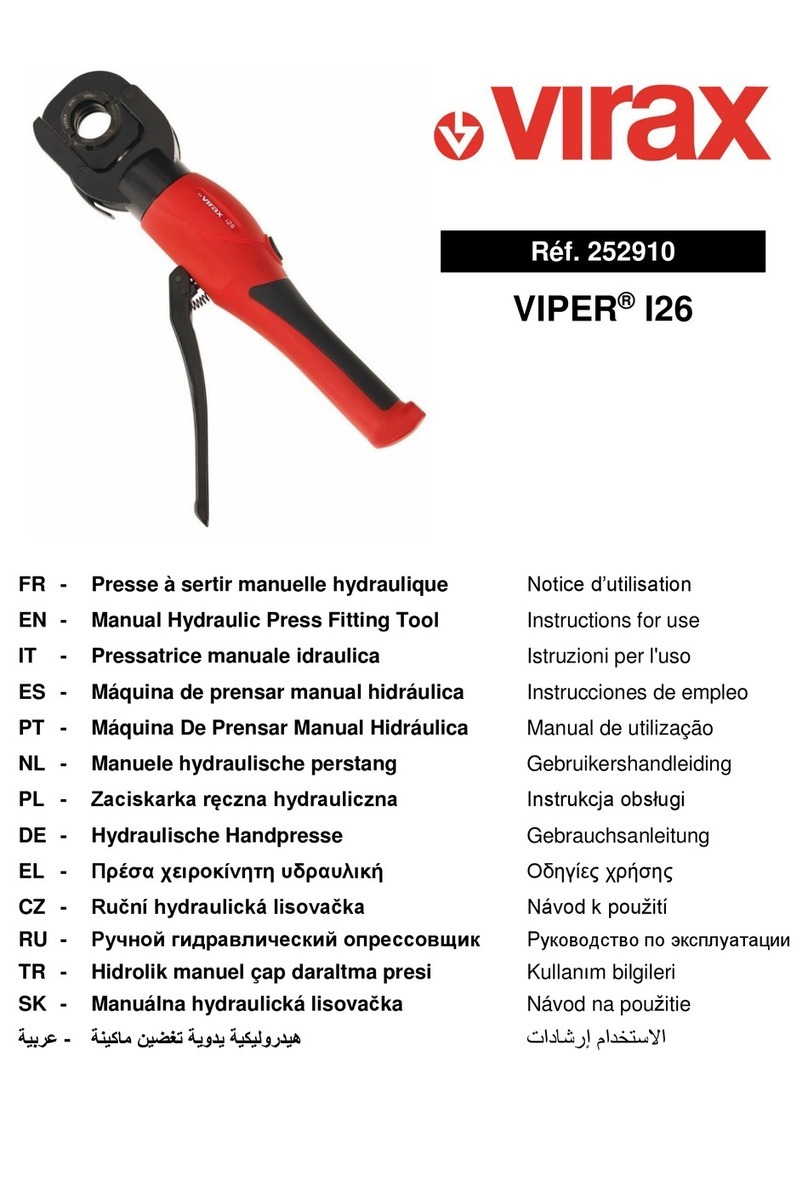Graco 258853 Operating instructions

3A0232E
ENG
Operation - Repair
RS Gun, Cutter
For use with polyester resin and gel-coat.
For professional use only.
See page 3 for model information, including maxi-
mum working pressure.
Patents Pending
Important Safety Instructions
Read all warnings and instructions in this
manual. Save these instructions.
258970_3A0232_1a
External Mix Chop Gun with Cutter shown
II 2 G c T6

23A0232E
Contents
Models . . . . . . . . . . . . . . . . . . . . . . . . . . . . . . . . . . . 3
Related Manuals . . . . . . . . . . . . . . . . . . . . . . . . . . . 3
Warnings . . . . . . . . . . . . . . . . . . . . . . . . . . . . . . . . . 4
Important Two-Component Information . . . . . . . . 6
Material Self-ignition . . . . . . . . . . . . . . . . . . . . . 6
Keep Components A and B Separate . . . . . . . . . 6
Changing Materials . . . . . . . . . . . . . . . . . . . . . . . 6
Important Methyl Ethyl Ketone Peroxide (MEKP)
Safety Information . . . . . . . . . . . . . . . . . . . . . . . 7
Component Identification . . . . . . . . . . . . . . . . . . . 10
External Mix Gel Gun, 258840 . . . . . . . . . . . . . 10
Internal Mix Gel Gun, 258853 . . . . . . . . . . . . . . 11
Internal Mix Chop Gun, 258854 . . . . . . . . . . . . 12
External Mix Chop Gun, 258852 . . . . . . . . . . . 13
Cutter, 24E512 . . . . . . . . . . . . . . . . . . . . . . . . . 14
Theory of Operation . . . . . . . . . . . . . . . . . . . . . . . 15
External Mix . . . . . . . . . . . . . . . . . . . . . . . . . . . 15
Internal Mix . . . . . . . . . . . . . . . . . . . . . . . . . . . . 15
Chop Guns . . . . . . . . . . . . . . . . . . . . . . . . . . . . 15
Impingement versus Standard Spray Tips . . . . 15
Air Assist Containment (AAC) . . . . . . . . . . . . . . 15
Grounding . . . . . . . . . . . . . . . . . . . . . . . . . . . . . . . 15
Trigger Lock . . . . . . . . . . . . . . . . . . . . . . . . . . . . . . 15
Setup . . . . . . . . . . . . . . . . . . . . . . . . . . . . . . . . . . . . 16
Operation . . . . . . . . . . . . . . . . . . . . . . . . . . . . . . . . 18
Trigger Lock . . . . . . . . . . . . . . . . . . . . . . . . . . . . 18
AAC Adjustment . . . . . . . . . . . . . . . . . . . . . . . . 18
Trigger Clamp Adjustment Procedure . . . . . . . . 18
Trigger Adjustment . . . . . . . . . . . . . . . . . . . . . . 19
Internal Mix Flush . . . . . . . . . . . . . . . . . . . . . . . 19
Cutter Assembly . . . . . . . . . . . . . . . . . . . . . . . . 20
Adjust Anvil to Idler Tension . . . . . . . . . . . . . . . 21
Blower Air Adjustment . . . . . . . . . . . . . . . . . . . . 21
Pressure Relief Procedure . . . . . . . . . . . . . . . . . . 22
Shutdown . . . . . . . . . . . . . . . . . . . . . . . . . . . . . . . . 22
Daily . . . . . . . . . . . . . . . . . . . . . . . . . . . . . . . . . 22
Long-Term . . . . . . . . . . . . . . . . . . . . . . . . . . . . . 22
Maintenance . . . . . . . . . . . . . . . . . . . . . . . . . . . . . . 23
Daily Cleaning . . . . . . . . . . . . . . . . . . . . . . . . . . 23
Flush Gun . . . . . . . . . . . . . . . . . . . . . . . . . . . . . 23
Clean Gun Front End . . . . . . . . . . . . . . . . . . . . 24
Replace Internal Mix Element . . . . . . . . . . . . . 25
Replace External Mix Check Valve and O-Rings 26
Adjust Needle Packing . . . . . . . . . . . . . . . . . . . 27
Replace Needle Packing . . . . . . . . . . . . . . . . . . 27
Replace Material Needle Assembly . . . . . . . . . 28
Replace Center Needle Assembly . . . . . . . . . . 28
Air Motor Oiling . . . . . . . . . . . . . . . . . . . . . . . . . 28
Anvil Replacement . . . . . . . . . . . . . . . . . . . . . . 29
Blade Cartridge Replacement . . . . . . . . . . . . . 29
Troubleshooting . . . . . . . . . . . . . . . . . . . . . . . . . . . 30
Parts . . . . . . . . . . . . . . . . . . . . . . . . . . . . . . . . . . . . 34
External Mix Gel Gun, 258840 . . . . . . . . . . . . . 34
Internal Mix Gel Gun, 258853 . . . . . . . . . . . . . . 36
External Mix Chop Gun with Cutter, 258970 . . . 39
Internal Mix Chop Gun with Cutter, 258971 . . . 39
Chop Guns, 258852, 258854 . . . . . . . . . . . . . . 40
Cutter Assembly, 24E512 . . . . . . . . . . . . . . . . . 42
Front Head Assemblies . . . . . . . . . . . . . . . . . . . 44
Needle Assembly, 24E417 . . . . . . . . . . . . . . . . 46
O-ring Identification . . . . . . . . . . . . . . . . . . . . . . 47
Accessories . . . . . . . . . . . . . . . . . . . . . . . . . . . . . . 48
Field Install Kit, 257754 . . . . . . . . . . . . . . . . . . . 48
AAC Regulators . . . . . . . . . . . . . . . . . . . . . . . . . 48
Lubricant for Gun . . . . . . . . . . . . . . . . . . . . . . . . 48
External Mix High-Flow Kit, 24H336 . . . . . . . . . 48
Internal Mix High-Flow Kit, 24H337 . . . . . . . . . . 48
Chopper Air Shutoff, 24F706 . . . . . . . . . . . . . . 49
External Mix Gel Gun to Chop Gun Conversion 49
Oil for Air Motor . . . . . . . . . . . . . . . . . . . . . . . . . 49
Blade Cartridges . . . . . . . . . . . . . . . . . . . . . . . . 49
Air Motor Muffler . . . . . . . . . . . . . . . . . . . . . . . . 49
Tools . . . . . . . . . . . . . . . . . . . . . . . . . . . . . . . . . 49
Impingement Spray Tips . . . . . . . . . . . . . . . . . . 50
Standard Spray Tips . . . . . . . . . . . . . . . . . . . . . 51
Technical Data . . . . . . . . . . . . . . . . . . . . . . . . . . . . 52
Dimensions . . . . . . . . . . . . . . . . . . . . . . . . . . . . 53
Graco Standard Warranty . . . . . . . . . . . . . . . . . . . 54
Graco Information . . . . . . . . . . . . . . . . . . . . . . . . . 54

Models
3A0232E 3
Models
See Technical Data on page 52 for more specifications.
Related Manuals
Component manuals in English. Manuals are available
at www.graco.com.
Model Description
Maximum Fluid
Working Pressure
psi (MPa, bar)
Maximum Catalyst
Working Pressure
psi (MPa, bar)
Air Inlet Working
Pressure Range
psi (MPa, bar)
Maximum Fluid
Temperature
°F (°C)
258853 Internal Mix
Gel Gun 2000 (14, 138) 2000 (14, 138) 0-125
(0-0.86, 0-8.6) 100 (38)
258854
Internal Mix
Chop Gun,
No Cutter
2000 (14, 138) 2000 (14, 138) 0-125
(0-0.86, 0-8.6) 100 (38)
258971
Internal Mix
Chop Gun,
Cutter
2000 (14, 138) 2000 (14, 138) 80-125
(0.55-0.86, 5.5-8.6) 100 (38)
258840 External Mix
Gel Gun 3000 (21, 207) 200 (1.4, 14) 0-125
(0-0.86, 0-8.6) 100 (38)
258852
External Mix
Chop Gun,
No Cutter
3000 (21, 207) 200 (1.4, 14) 0-125
(0-0.86, 0-8.6) 100 (38)
258970
External Mix
Chop Gun,
Cutter
3000 (21, 207) 200 (1.4, 14) 80-125
(0.55-0.86, 5.5-8.6) 100 (38)
24E512 Cutter -- -- 80-125
(0.55-0.86, 5.5-8.6) --
Part Description
3A1226 RS Gun Field Install Kit Instructions

Warnings
43A0232E
Warnings
The following warnings are for the setup, use, grounding, maintenance, and repair of this equipment. The exclama-
tion point symbol alerts you to a general warning and the hazard symbols refer to procedure-specific risks. When
these symbols appear in the body of this manual, refer back to these Warnings. Product-specific hazard symbols and
warnings not covered in this section may appear throughout the body of this manual where applicable.
WARNING
FIRE AND EXPLOSION HAZARD
Flammable fumes, such as solvent and paint fumes, in work area can ignite or explode. To help
prevent fire and explosion:
• Use equipment only in well ventilated area.
• Eliminate all ignition sources; such as pilot lights, cigarettes, portable electric lamps, and plastic
drop cloths (potential static arc).
• Keep work area free of debris, including solvent, rags and gasoline.
• Do not plug or unplug power cords, or turn power or light switches on or off when flammable fumes
are present.
• Ground all equipment in the work area. See Grounding instructions.
• Use only grounded hoses.
• Hold gun firmly to side of grounded pail when triggering into pail.
• If there is static sparking or you feel a shock, stop operation immediately. Do not use equipment
until you identify and correct the problem.
• Keep a working fire extinguisher in the work area.
SKIN INJECTION HAZARD
High-pressure fluid from dispensing device, hose leaks, or ruptured components will pierce skin. This
may look like just a cut, but it is a serious injury that can result in amputation. Get immediate surgical
treatment.
• Engage trigger lock when not dispensing.
• Do not point dispensing device at anyone or at any part of the body.
• Do not put your hand over the fluid outlet.
• Do not stop or deflect leaks with your hand, body, glove, or rag.
• Follow the Pressure Relief Procedure when you stop dispensing and before cleaning, checking, or
servicing equipment.
• Tighten all fluid connections before operating the equipment.
• Check hoses and couplings daily. Replace worn or damaged parts immediately.
MOVING PARTS HAZARD
Moving parts can pinch, cut or amputate fingers and other body parts.
• Keep clear of moving parts.
• Do not operate equipment with protective guards or covers removed.
• Pressurized equipment can start without warning. Before checking, moving, or servicing equipment,
follow the Pressure Relief Procedure and disconnect all power sources.

Warnings
3A0232E 5
TOXIC FLUID OR FUMES HAZARD
Toxic fluids or fumes can cause serious injury or death if splashed in the eyes or on skin, inhaled, or
swallowed.
• Read MSDSs to know the specific hazards of the fluids you are using.
• Store hazardous fluid in approved containers, and dispose of it according to applicable guidelines.
• Always wear chemically impermeable gloves when spraying, dispensing, or cleaning equipment.
PERSONAL PROTECTIVE EQUIPMENT
You must wear appropriate protective equipment when operating, servicing, or when in the operating
area of the equipment to help protect you from serious injury, including eye injury, hearing loss,
inhalation of toxic fumes, and burns. This equipment includes but is not limited to:
• Protective eyewear, and hearing protection.
• Respirators, protective clothing, and gloves as recommended by the fluid and solvent manufacturer.
EQUIPMENT MISUSE HAZARD
Misuse can cause death or serious injury.
• Do not operate the unit when fatigued or under the influence of drugs or alcohol.
• Do not exceed the maximum working pressure or temperature rating of the lowest rated system
component. See Technical Data in all equipment manuals.
• Use fluids and solvents that are compatible with equipment wetted parts. See Technical Data in all
equipment manuals. Read fluid and solvent manufacturer’s warnings. For complete information
about your material, request MSDS from distributor or retailer.
• Do not leave the work area while equipment is energized or under pressure. Turn off all equipment
and follow the Pressure Relief Procedure when equipment is not in use.
• Check equipment daily. Repair or replace worn or damaged parts immediately with genuine
manufacturer’s replacement parts only.
• Do not alter or modify equipment.
• Use equipment only for its intended purpose. Call your distributor for information.
• Route hoses and cables away from traffic areas, sharp edges, moving parts, and hot surfaces.
• Do not kink or over bend hoses or use hoses to pull equipment.
• Keep children and animals away from work area.
• Comply with all applicable safety regulations.
PRESSURIZED ALUMINUM PARTS HAZARD
Use of fluids that are incompatible with aluminum in pressurized equipment can cause serious
chemical reaction and equipment rupture. Failure to follow this warning can result in death, serious
injury, or property damage.
• Do not use 1,1,1-trichloroethane, methylene chloride, other halogenated hydrocarbon solvents or
fluids containing such solvents.
• Many other fluids may contain chemicals that can react with aluminum. Contact your material
supplier for compatibility.
WARNING

Important Two-Component Information
63A0232E
Important Two-Component Information
Material Self-ignition
Keep Components A and B
Separate
Changing Materials
• When changing materials, flush the equipment mul-
tiple times to ensure it is thoroughly clean.
• Always clean the fluid inlet strainers after flushing.
• Check with your material manufacturer for chemical
compatibility.
Some materials may become self-igniting if applied
too thickly. Read material manufacturer’s warnings
and material MSDS.
Cross-contamination can result in cured material in
fluid lines which could cause serious injury or
damage equipment. To prevent cross-contamination
of the equipment’s wetted parts, never interchange
component A (catalyst) and component B (resin)
parts.

Important Methyl Ethyl Ketone Peroxide (MEKP) Safety Information
3A0232E 7
Important Methyl Ethyl Ketone Peroxide (MEKP)
Safety Information
MEKP is among the more hazardous materials found in
commercial channels. Proper handling of the “unstable
(reactive)” chemicals presents a definite challenge to
the plastics industry. The highly reactive property which
makes MEKP valuable to the plastics industry in produc-
ing the curing reaction of polyester resins and gel-coats
also produces the hazards which require great care and
caution in its storage, transportation, handling, process-
ing and disposal.
Workers must be thoroughly informed of the hazards
that may result from improper handling of MEKP, espe-
cially in regards to contamination and heat. They must
be thoroughly instructed regarding the proper action to
be taken in the storage, use and disposal of MEKP and
other hazardous materials used in the laminating opera-
tion.
MEKP is flammable and potentially explosive, as
well as potentially damaging to the eyes and skin.
Read material manufacturer’s warnings and
material MSDS to know specific hazards and pre-
cautions related to MEKP.
Contaminated MEKP can become explosive. Pre-
vent contamination of MEKP with other materials,
which includes, but is not limited to polyester over-
spray, polymerization accelerators and promoters,
and non-stainless metals. Even small amounts of
contaminates can make MEKP explosive. This reac-
tion may start slowly, and gradually build-up heat,
which can accelerate until fire or an explosion result.
This process can take from seconds to days.
Heat applied to MEKP, or heat build-up from con-
tamination reactions can cause it to reach what is
called its Self-Accelerating Decomposition Tempera-
ture (SADT), which can cause fire or explosion. Spills
should be promptly removed, so no residues remain.
Spillage can heat up to the point of self-ignition. Dis-
pose in accordance with manufacture’s recommenda-
tion.
Store MEKP in a cool, dry and well-ventilated area
in the original containers away from direct sunlight
and away from other chemicals. It is strongly recom-
mended that the storage temperature remain below
86° F (30° C). Heat will increase the potential for
explosive decomposition. Refer to NFPA 432. Keep
MEKP away from heat, sparks and open flames.
Current catalysts are premixed and do not require
any diluents. Graco strongly recommends that dilu-
ents not be used. Diluents add to the possibility of
contaminates entering the catalyst system. Never
dilute MEKP with acetone or any solvent since this
can produce an extremely shock-sensitive compound
which can explode.
Use only original equipment or equivalent parts
from Graco in the catalyst system (i.e.: hoses, fittings,
etc.) because a hazardous chemical reaction may
result between substituted parts and MEKP.
To prevent contact with MEKP, appropriate per-
sonal protective equipment, including chemically
impermeable gloves, boots, aprons and goggles are
required for everyone in the work area.

Important Methyl Ethyl Ketone Peroxide (MEKP) Safety Information
83A0232E
Polyester Resins and Gel-Coats
Spraying and Lamination Operations
NOTE: Graco recommends that you consult OSHA Sec-
tions 1910.94, 1910.106, 1910.107 and NFPA No. 33,
Chapter 16,17, and NFPA No. 91 for further guidance.
Spraying materials containing polyester resin and
gel-coats creates potentially harmful mist, vapors and
atomized particulates. Prevent inhalation by providing
sufficient ventilation and the use of respirators in the
work area.
Read the material manufacturer’s warnings and
material MSDS to know specific hazards and precau-
tions related to polyester resins and gel-coats.
To prevent contact with polyester resins and
gel-coats, appropriate personal protective equipment,
including chemically impermeable gloves, boots,
aprons and goggles are required for everyone in the
work area.
Remove all accumulations of overspray, FRP
sandings, etc. from the building as they occur. If this
waste is allowed to build up, spillage of catalyst is
more likely to start a fire.
If cleaning solvents are required, read material
manufacture’s warnings and material MSDS to know
specific hazards and precautions. (Graco recom-
mends that clean-up solvents be nonflammable.)

Important Methyl Ethyl Ketone Peroxide (MEKP) Safety Information
3A0232E 9

Component Identification
10 3A0232E
Component Identification
External Mix Gel Gun, 258840
FIG. 1
Key:
A Trigger Clamp Assembly
B Gun Mount
C Front Head Locking Ring
D Air Cap Retaining Ring
E External Mix Aircap
F External Mix Front Head
GSprayTip
H Trigger guard
J Trigger
K Trigger lock
L Handle
M Actuator Pin
A
B
C
H
J
K
L
M
E
D
G
F
258840_3A0232_1g

Component Identification
3A0232E 11
Internal Mix Gel Gun, 258853
NOTE: On internal mix guns, the tip rotates to allow ver-
tical or horizontal spray pattern.
FIG. 2
Key:
A Trigger Clamp Assembly
BGunMount
C Front Head Locking Ring
D Air Cap Retaining Ring
E Internal Mix Aircap
F Internal Mix Front Head
GSprayTip
H Trigger guard
J Trigger
K Trigger lock
L Handle
M Actuator Pin
AB
258853_3A0232_1h
C
D
E
F
H
J
K
G
L
M

Component Identification
12 3A0232E
Internal Mix Chop Gun, 258854
NOTE: On internal mix guns, the tip rotates to allow ver-
tical or horizontal spray pattern.
FIG. 3
Key:
A Trigger Clamp Assembly
B Cutter Mount
C Front Head Locking Ring
D Air Cap Retaining Ring
E Internal Mix Aircap
F Internal Mix Front Head
GSprayTip
H Trigger guard
J Trigger
K Trigger lock
L Handle
MActuatorPin
258854_3A0232_1h
AB
C
D
E
F
H
J
K
G
L
M

Component Identification
3A0232E 13
External Mix Chop Gun, 258852
FIG. 4
Key:
A Trigger Clamp Assembly
B Cutter Mount
C Front Head Locking Ring
D Air Cap Retaining Ring
E External Mix Aircap
F External Mix Front Head
GSprayTip
H Trigger guard
J Trigger
K Trigger lock
L Handle
M Actuator Pin
258852_3A0232_2g
AB
C
D
E
F
H
J
K
G
L
M

Component Identification
14 3A0232E
Cutter, 24E512
FIG. 5
Key:
AA Blade Cartridge
AB Cutter Head Assembly Cap
AC Anvil
AD Anvil Cap
AE Glass Feed
AF Anvil to Blade Tension
Adjustment Knob
AG Anvil to Blade Tension
Lockdown
AH Air Motor
AJ Idler Wheel
AK Motor Lock button
AL Cover (not shown)
AM Chute (not shown)
AA
AB
AC
AD
AE
AF
AG
AH
AJ 258900_3A0232_1j
AK

Theory of Operation
3A0232E 15
Theory of Operation
External Mix
The independent material stream, resin or gelcoat, and
catalyst impinge when they exit the spray tip. The cata-
lyst is atomized with air pressure and is contained by
AAC air to achieve high mix quality. This reduces inter-
nal clogs from cured material.
Internal Mix
The material and catalyst pass through an internal static
mixer where they mix. The mixed solution is dispensed.
Chop Guns
Fiberglass is pulled through cutter and cut into small
strands. The cut strands are then dispensed into the
mixed material stream.
Impingement versus Standard
Spray Tips
Impingement spray tips are typically for chop guns. This
utilizes multiple impinging streams to create the fan pat-
tern.
Standard spray tips are typically for gel guns. This uti-
lizes a single cat-eye shaped orifice to create the fan
pattern.
Air Assist Containment (AAC)
When material exits the spray tip, air is sprayed against
the material stream to shape it into a more consistent
pattern.
Grounding
Trigger Lock
This equipment must be grounded.
Grounding reduces the risk of static shock by providing
an escape wire for electrical current due to static build
up or in the event of short circuit.
NOTE: Grounding wire and clamp assembly 17440-00
is included with Graco FRP proportioner. If using a dif-
ferent proportioner that does not come with a ground-
ing wire and clamp assembly, order 17440-00 or
provide your own.
Ground the dispense gun through connection to a
Graco approved grounded fluid supply hose.
Check your local electrical code and related manuals
for detailed grounding instructions of all equipment in
the work area.
Engage trigger lock whenever you stop spraying to
avoid accidental triggering.
Engage Disengage
TI10442a TI10441a

Setup
16 3A0232E
Setup
1. Before first use, flush the gun. The equipment was
tested with lightweight oil, which is left in the fluid
passages to protect parts. To avoid contaminating
your fluid with oil, flush the equipment with a com-
patible solvent before using the equipment. See
Flush Gun, page 23.
2. Engage trigger lock.
3. For guns with cutters, install cutter:
a. If necessary, use a crescent wrench to adjust
pivot (541) so that it is parallel to gun front end.
See Chop Guns, 258852, 258854 on page 40.
b. If necessary, use a crescent wrench to adjust
pivot so that open end points to front of gun.
c. Back out screws (630). See Cutter Assembly,
24E512 on page 42.
d. Install cutter onto pivot so glass feed holes are
on top.
e. Tighten screws (630) to lock cutter in place.
f. Adjust cutter dispensing angle and chute angle
as desired.
4. For internal mix guns, verify solvent knob (BD) is
adjusted to the fully closed position. See FIG. 6 on
page 17.
5. Attach gun connections as described in FIG. 6 on
page 17. See Technical Data on page 52 for fitting
sizes.
6. For internal mix guns, prime the solvent line. Turn
solvent adjustment knob (BD) until solvent dis-
charges from the front of the gun. See FIG. 6 on
page 17.
7. For guns with cutters, insert glass strands into
feed.
8. For guns with cutters, adjust anvil to blade ten-
sion:
a. Release lockdown (AG). See FIG. 5 on page 14.
b. Adjust tension knob (AF) as desired.
c. Tighten lockdown (AG).
d. Perform test spray to verify proper cutting of
glass strands.
e. Adjust tension as necessary.
9. For external mix guns, adjust AAC knob (BD) to
middle of possible range of movement. See FIG. 6
on page 17.
10. Adjust AAC pressure on proportioner.
11. Perform test spray. Adjust system and gun settings
as necessary to get desired results.
NOTICE
To prevent material curing inside the gun, do not
trigger gun if solvent is not primed.

Setup
3A0232E 17
FIG. 6: Fitting Details
BB
BABE
BF
258840_3A0232_2g
Ref External Mix Internal Mix Chop Internal Mix Gel Fitting Size
BA Atomized Air
(Catalyst)
Air Assist Contain-
ment (AAC) Plugged 1/4 tube
BB Resin Inlet 1/4 NPSM
BC Air Assist Con-
tainment (AAC) Solvent 1/8 NPSM
BD Adjustment Knob --
BE Chop Air Inlet Air Assist Contain-
ment (AAC) 3/8 tube
BF Catalyst Inlet #4 JIC
BC
BD

Operation
18 3A0232E
Operation
Trigger Lock
AAC Adjustment
If the spray pattern is not even, the AAC air pressure
may need to be adjusted. For all guns, the AAC air pres-
sure is set at the system. The external mix gun includes
an AAC air pressure adjustment on the gun also, see
AAC reference in FIG. 6 on page 17. To increase AAC air
pressure on the external mix gun, turn knob coun-
ter-clockwise. To decrease air pressure, turn knob clock-
wise. For large changes in AAC air pressure, adjust the
pressure at the system.
Trigger Clamp Adjustment
Procedure
1. Engage trigger lock.
2. Loosen four screws (113). Do not remove.
3. While pushing the trigger clamp assembly (111)
against the gun body, use a 9/64 in. hex key to
lightly tighten the four screws.
4. Torque the four screws to 22-24 in-lb (2.5-2.7 N•m)
in the following order: inner two screws first then
outer two screws last.
NOTE: Be careful not to overtighten trigger clamp
assembly as this will cause the material needles to bind
and cause material needles to operate incorrectly.
High-pressure fluid from gun, hose leaks, or ruptured
components will pierce skin. This may look like just a
cut, but it is a serious injury that can result in amputa-
tion. Get immediate surgical treatment.
• Do not point gun at anyone or at any part of the
body.
• Do not put your hand over the dispense outlet.
• Do not stop or deflect leaks with your hand, body,
glove, or rag.
• Follow Pressure Relief Procedure when you
stop dispensing and before cleaning, checking, or
servicing equipment.
Engage trigger lock whenever you stop spraying to
avoid accidental triggering.
FIG. 7
Bad
Good
FIG. 8
111
113

Operation
3A0232E 19
Trigger Adjustment
When the trigger is pulled, it moves the trigger clamp
assembly resulting in fluid flow from each component.
The actuator pins are factory set. If the trigger, trigger
clamp assembly, or pins are removed then the trigger
may need to be adjusted.
1. Perform Pressure Relief Procedure, page 22.
2. Engage trigger lock.
3. Use 5/64 in. Remove adjuster screws (114).
4. Apply medium strength thread sealant to threads of
screws.
5. Install adjuster screws (114) into trigger clamp
assembly (111).
6. Squeeze trigger so that it touches the trigger lock. If
trigger cannot touch trigger lock, back out adjuster
screws until trigger touches the trigger lock.
7. Adjust each screw until the actuator pin just begins
to touch the trigger. This can be verified by the trig-
ger just beginning to lift off of the trigger lock.
8. Back each screw out 1/2 turn.
9. Disengage trigger lock.
10. While watching the trigger clamp assembly, trigger
the gun to verify both sides of the trigger clamp
assembly pull away from the gun body at the same
time.
11. Hold the trigger fully engaged and measure the
space between the trigger clamp and the gun body
on both sides. The gaps should be at least 0.065 in.
(1.65 mm) in the open position. Adjust screws as
necessary. See FIG. 10.
Internal Mix Flush
After spraying, open the solvent knob (BC) to allow sol-
vent to flow through the gun. See FIG. 6 on page 17.
While flushing, hold a metal part of the gun firmly to a
grounded metal pail.
FIG. 9
114
111
FIG. 10
Good Bad

Operation
20 3A0232E
Cutter Assembly
RS guns with a cutter installed have two modes of oper-
ation. When the trigger is pulled halfway, material sprays
but the cutter is not activated. When the trigger is pulled
all the way, the air motor in the cutter is started and
glass begins dispensing.
Adjust Cutter Speed
When dispensing a material and glass mixture, the
speed at which the cutter spins can be adjusted to
ensure the ratio of glass to dispensed material.
1. Determine whether more or less glass is needed.
a. Place bag over cutter chute.
b. Place bag over gun fluid outlet. Try to keep bag
away from the dispense outlet to prevent pierc-
ing the bag which will lead to inaccurate dis-
pense measurements.
c. Dispense a 15-30 second shot.
d. Weigh both bags and calculate ratio.
e. Determine whether more or less glass is
needed. Consult material manufacturer recom-
mendations for ratio requirements.
f. If ratio is ok, then no adjustment is needed. Oth-
erwise, continue with adjustment procedure.
2. Engage trigger lock.
3. With the trigger lock engaged, rotate the cutter
motor (AJ): clockwise to decrease speed, coun-
ter-clockwise to increase speed. See FIG. 11.
4. Go to step 1 to test ratio and repeat adjustment as
necessary.
Adjust Anvil to Blade Cartridge Tension
To cut the glass strands, the blade cartridge is pressed
against the anvil. If the strands do not appear to be get-
ting cut correctly an adjustment may be needed.
To adjust the tension:
1. Engage trigger lock.
2. Disengage the tension lockdown (AG) by pushing
towards the front of the gun.
3. Turn the tension knob (AF) on the cutter: coun-
ter-clockwise to increase tension, clockwise to
decrease tension. See FIG. 11.
4. Engage tension lockdown.
NOTE: More tension leads to the anvil and blade car-
tridge wearing out faster. Do not apply more tension
than is necessary.
FIG. 11
AH
AF
AG
258900_3A0232_1j
AC
AJ
To prevent skin injection, engage the trigger lock
before adjusting cutter motor.
This manual suits for next models
6
Table of contents
Other Graco Tools manuals
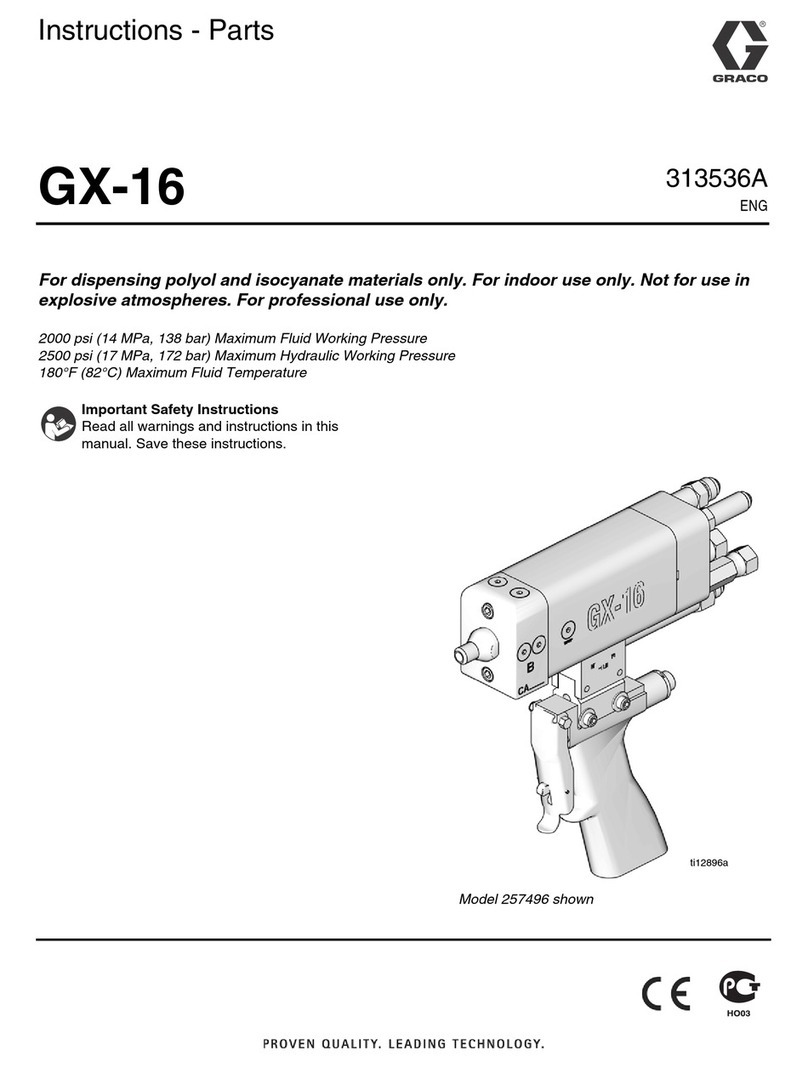
Graco
Graco GX-16 User manual
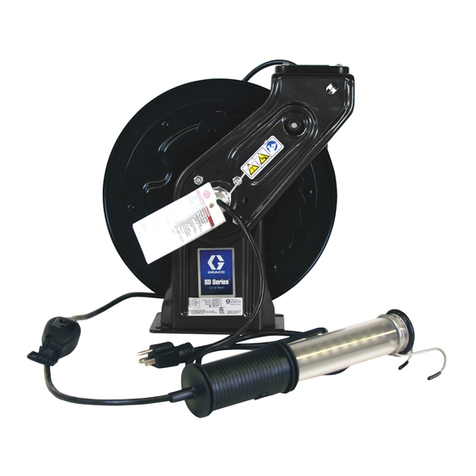
Graco
Graco SD Series User manual
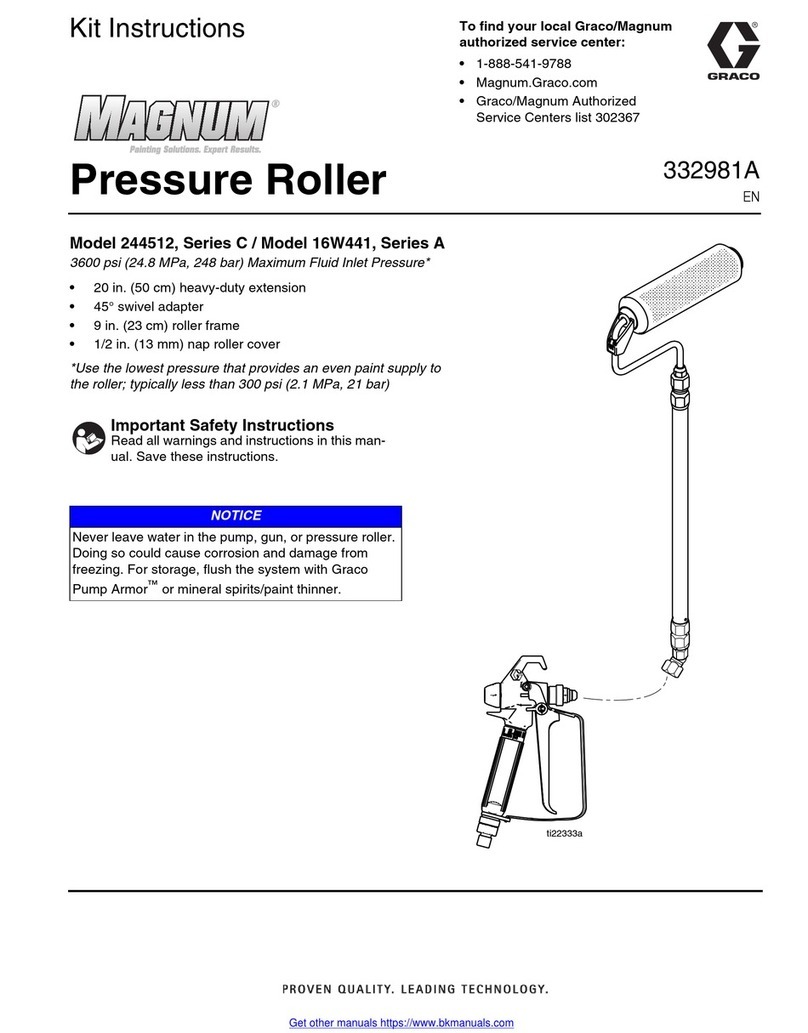
Graco
Graco MAGNUM C Series Manual

Graco
Graco SD Series Use and care manual
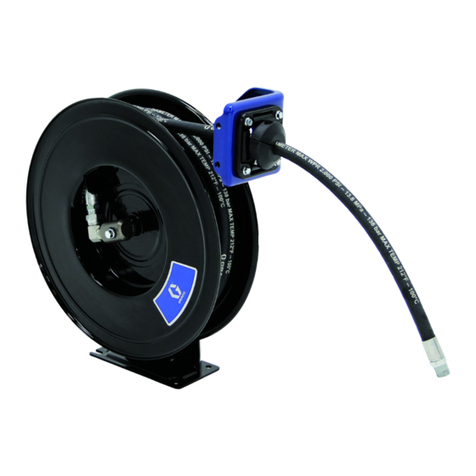
Graco
Graco SDX Series User manual

Graco
Graco SDX Series User manual
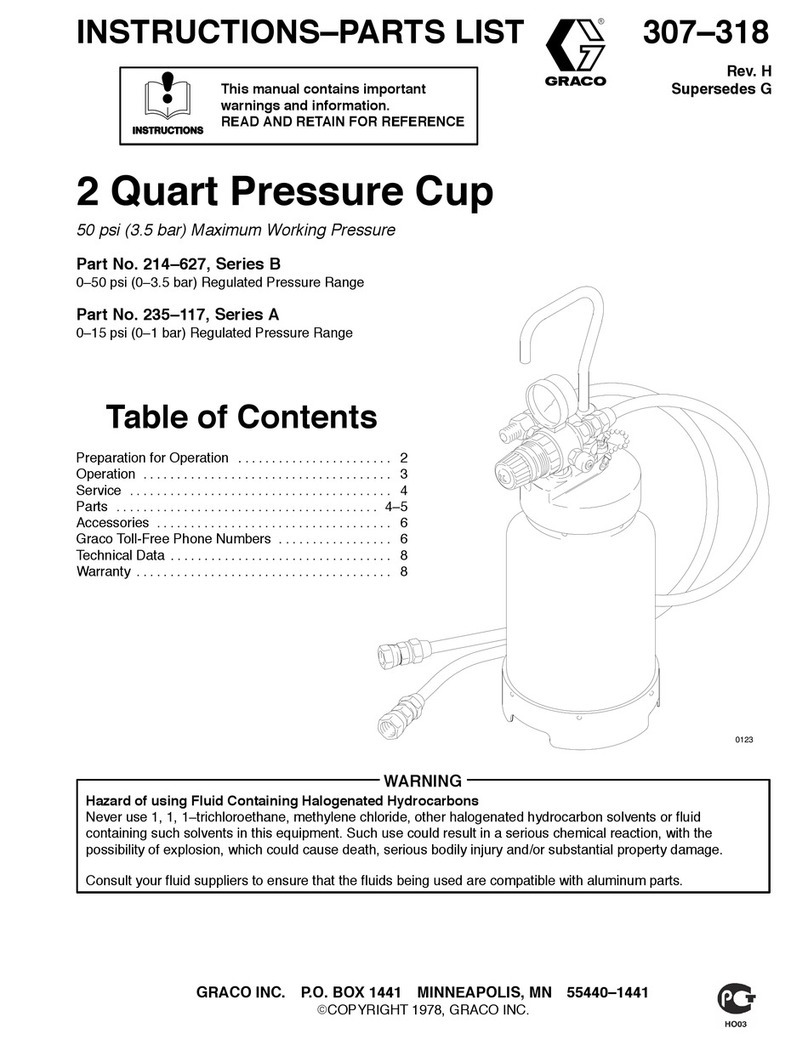
Graco
Graco 214-627 User manual

Graco
Graco 208-327 Operation manual
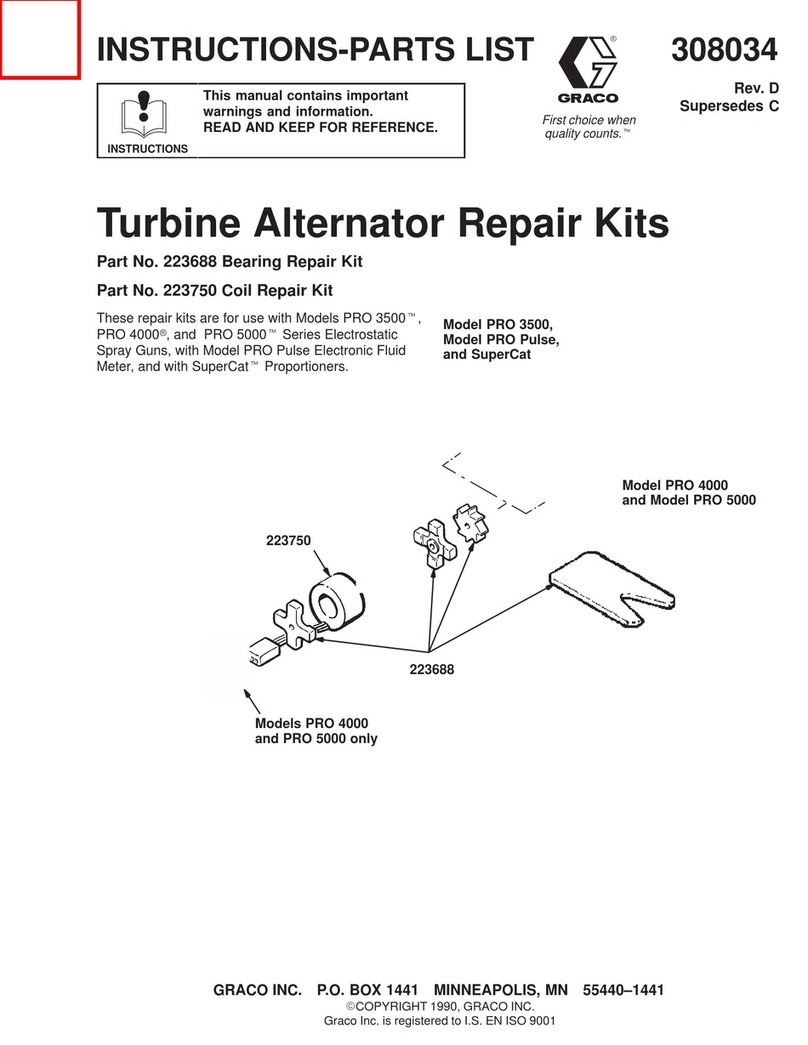
Graco
Graco 223688 Operation manual

Graco
Graco XD40 User manual
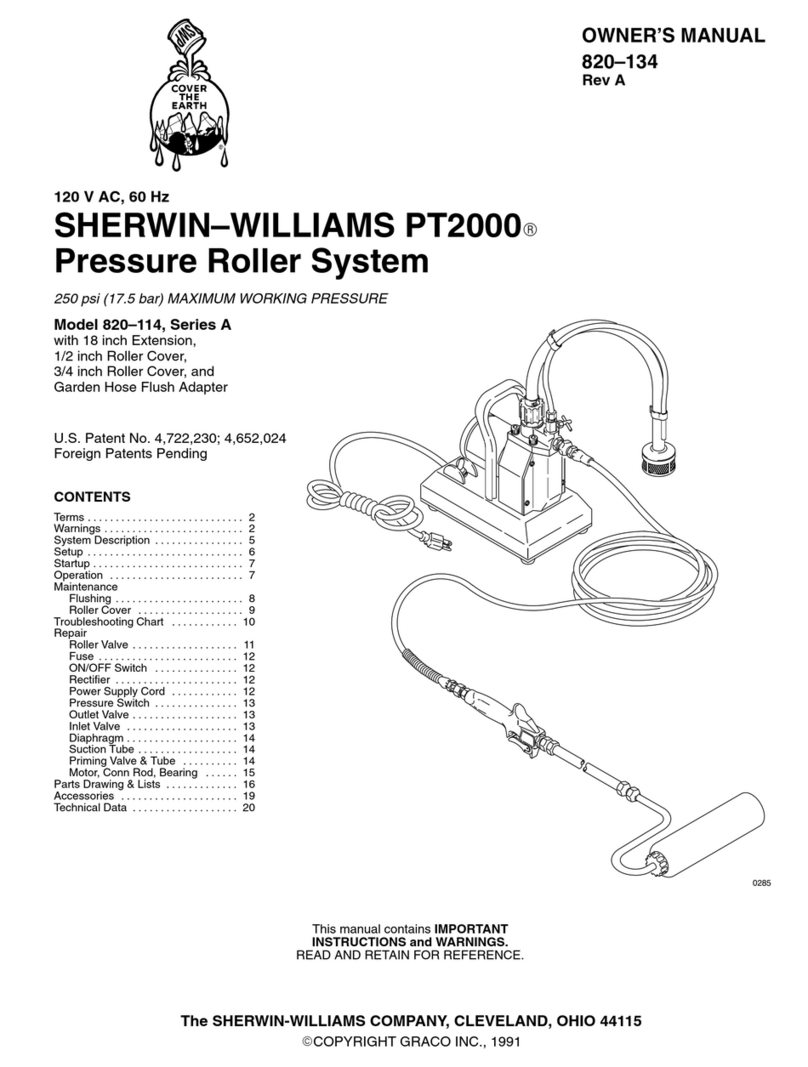
Graco
Graco PT2000 User manual
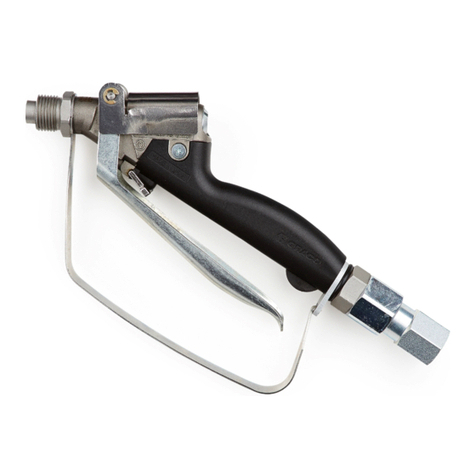
Graco
Graco 245820 User manual

Graco
Graco LDX Series Use and care manual

Graco
Graco 241105 Operation manual

Graco
Graco SD Composite Series User manual
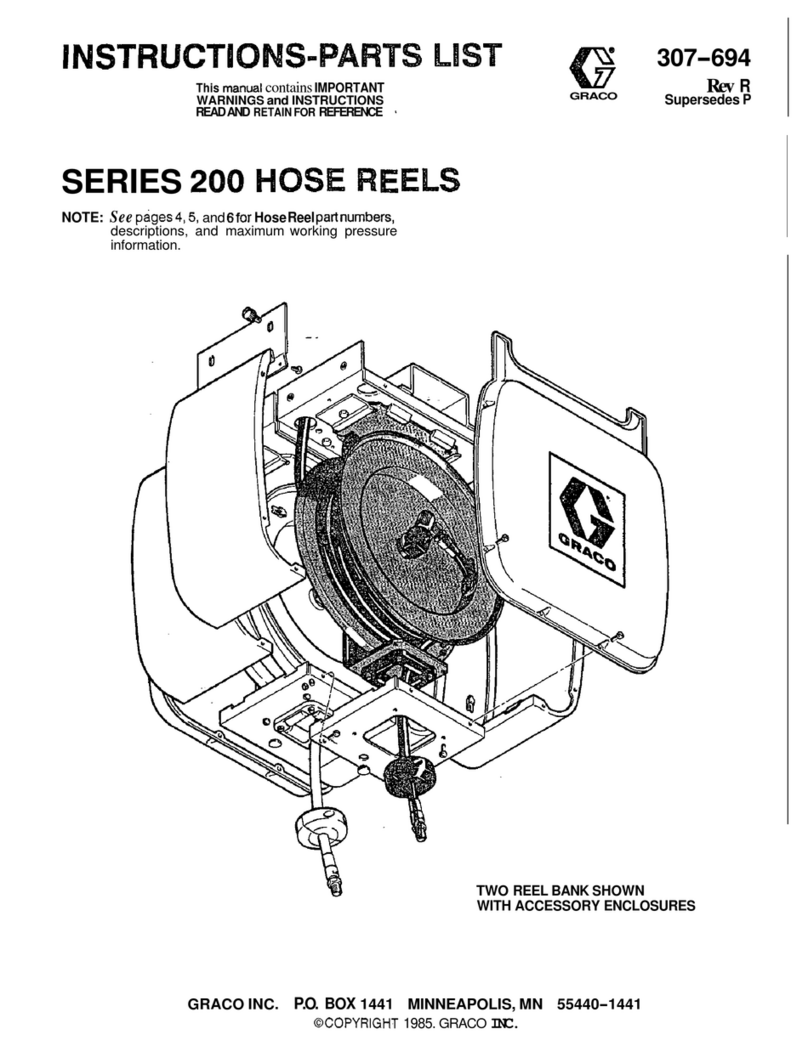
Graco
Graco 200 Series Operation manual
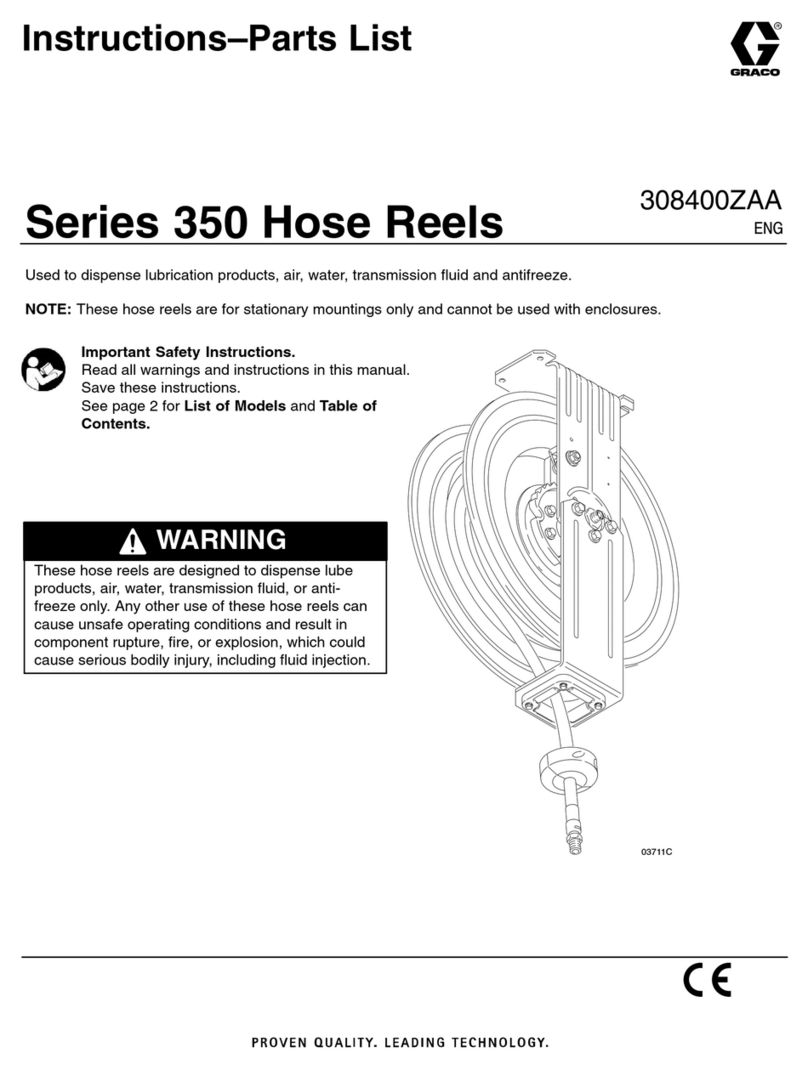
Graco
Graco 350 Series Operation manual

Graco
Graco SD Series User manual
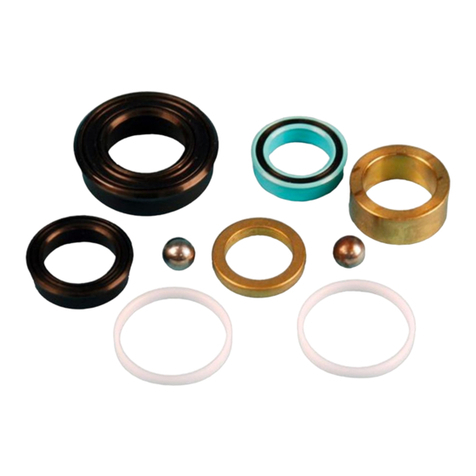
Graco
Graco 241623 User manual
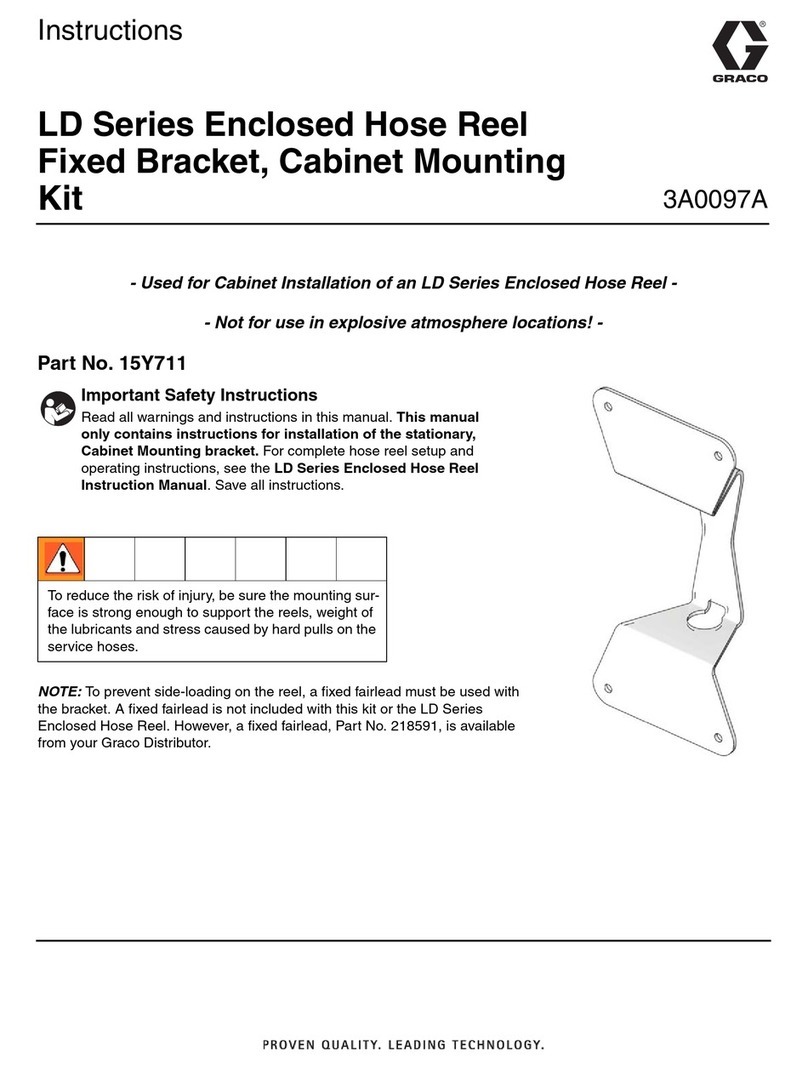
Graco
Graco LD Series User manual

